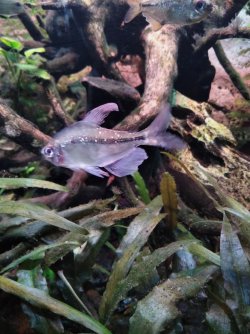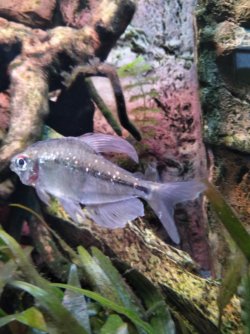Luna Aware Wolf
New Member
Hello, Thank you ever so much for taking a look at this thread and my fish! I appreciate it ever so much.
I have a 120l Lido Juwel tank, with 15 Diamond Tetra (that have been happily breeding for the last two years), a 17 year old Bristlenose Pleco, 5 Amano shrimp and 2 Ottos. I absolutely love fish keeping, I am self taught like most fish keeping enthusiasts, which leads to so much anxiety when things go wrong.
I am absolutely panicking as I am struggling to diagnose my fish and I am so worried it might be fish Tb? I made the stupid decision a year ago to introduce 6 Ottos to my mature tank from my quarantine tank prematurely, as they seemed healthy but would not eat and looked dangerously skinny so in a bid to safe them I took a risk.
I have not stopped having problems since adding these Ottos, some of which I sadly lost even after my best efforts. After adding them some of my older fish developed red gills, cloudy eyes, loss of appetite, rapidly losing weight, flashing, hiding in the tank and something wrong with some of their mouths. I thought it was Fluke so dosed the tank as instructed with Fluke Solve a few times, did water changes and monitored for four weeks.
This was 4th of March 2022, I managed to save most of my fish, they started having lots of fry, slowly gained some of the weight back and seemed happy. Please see before and after photo included. None of the younger fish or fry showered any signs of illness at all and all seemed fine.
But now the problem has come back and 3 of my oldest and most loved Diamond Tetra fish, that were original ill a year ago, have developed slightly bent spines and look like they are losing weight again, really red gills and one has a slightly cloudy eye. A Otto is showing similar symptoms too. I am totally at a loss as my water parameters seems fine, please see photo included that I did yesterday from my test kit, and I do weekly 25% or 50% water changes.
On Monday I also rescued some fish from a hording situation. I tested the water from their original tank, which had high ammonia and nitrate levels. The fish were clearly suffering from neglect, fin rot, mouth fungus, ammonia poisoning, red streaks and blood on their bodies and anus, total loss of colours and high levels of stress. Unfortunately, even to my best efforts, I lost 2 of them and one I gently put to sleep. I only now have one Peppered Cory left in my hospital tank and I am greatly worried for his survival rate, though they are now eating, their colour has returned and I'm doing a 50% water change in the hospital tank every day and dosing with Seachem Stess Gaurd and giving them small amounts of catfish pellets and blood worm. I am about to start dosing the tank work fin rot treatment just in case.
Any help would be so so appreciated and would mean so much as I don't want to lose any fish! Thank you for giving this a read too.
Hope you are having a nice day!












I have a 120l Lido Juwel tank, with 15 Diamond Tetra (that have been happily breeding for the last two years), a 17 year old Bristlenose Pleco, 5 Amano shrimp and 2 Ottos. I absolutely love fish keeping, I am self taught like most fish keeping enthusiasts, which leads to so much anxiety when things go wrong.
I am absolutely panicking as I am struggling to diagnose my fish and I am so worried it might be fish Tb? I made the stupid decision a year ago to introduce 6 Ottos to my mature tank from my quarantine tank prematurely, as they seemed healthy but would not eat and looked dangerously skinny so in a bid to safe them I took a risk.
I have not stopped having problems since adding these Ottos, some of which I sadly lost even after my best efforts. After adding them some of my older fish developed red gills, cloudy eyes, loss of appetite, rapidly losing weight, flashing, hiding in the tank and something wrong with some of their mouths. I thought it was Fluke so dosed the tank as instructed with Fluke Solve a few times, did water changes and monitored for four weeks.
This was 4th of March 2022, I managed to save most of my fish, they started having lots of fry, slowly gained some of the weight back and seemed happy. Please see before and after photo included. None of the younger fish or fry showered any signs of illness at all and all seemed fine.
But now the problem has come back and 3 of my oldest and most loved Diamond Tetra fish, that were original ill a year ago, have developed slightly bent spines and look like they are losing weight again, really red gills and one has a slightly cloudy eye. A Otto is showing similar symptoms too. I am totally at a loss as my water parameters seems fine, please see photo included that I did yesterday from my test kit, and I do weekly 25% or 50% water changes.
On Monday I also rescued some fish from a hording situation. I tested the water from their original tank, which had high ammonia and nitrate levels. The fish were clearly suffering from neglect, fin rot, mouth fungus, ammonia poisoning, red streaks and blood on their bodies and anus, total loss of colours and high levels of stress. Unfortunately, even to my best efforts, I lost 2 of them and one I gently put to sleep. I only now have one Peppered Cory left in my hospital tank and I am greatly worried for his survival rate, though they are now eating, their colour has returned and I'm doing a 50% water change in the hospital tank every day and dosing with Seachem Stess Gaurd and giving them small amounts of catfish pellets and blood worm. I am about to start dosing the tank work fin rot treatment just in case.
Any help would be so so appreciated and would mean so much as I don't want to lose any fish! Thank you for giving this a read too.
Hope you are having a nice day!





